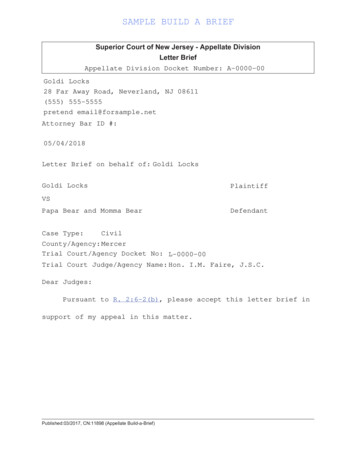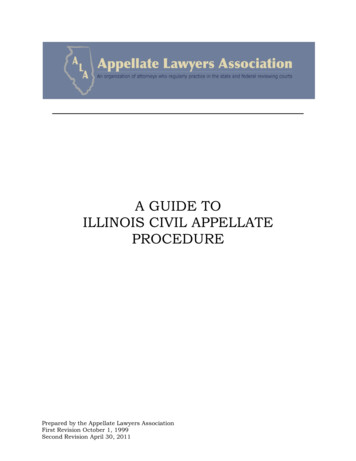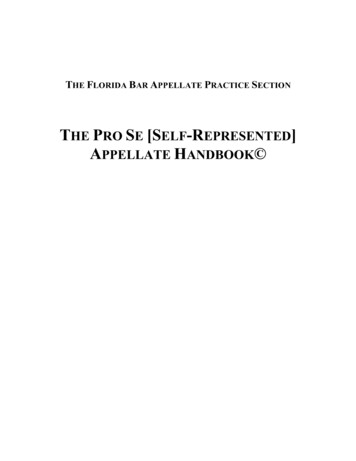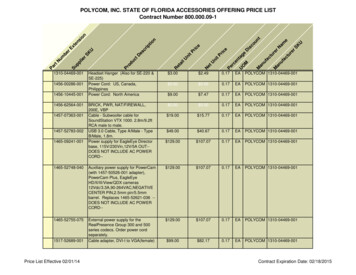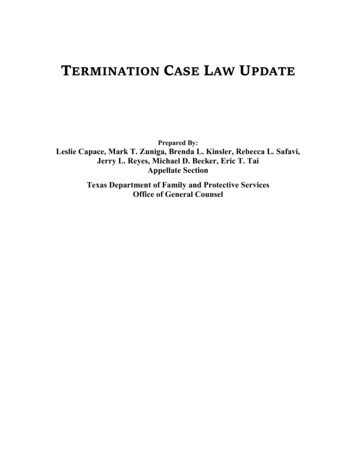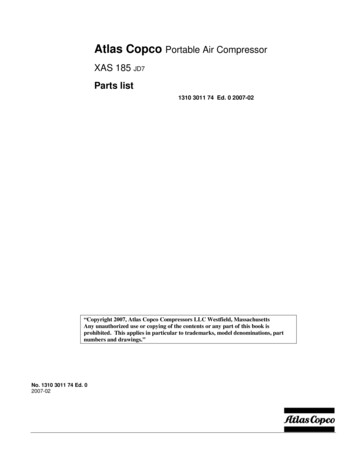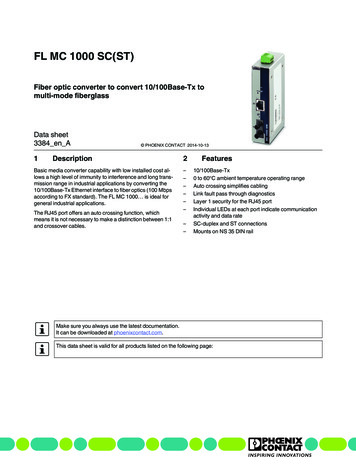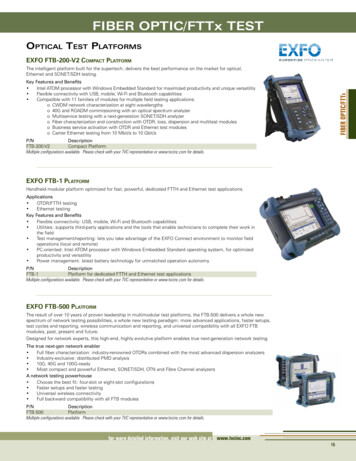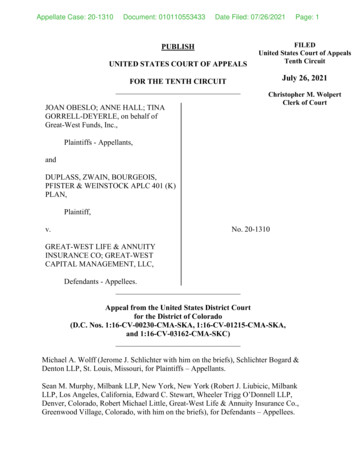
Transcription
Appellate Case: 20-1310Document: 010110553433Date Filed: 07/26/2021PUBLISHUNITED STATES COURT OF APPEALSFOR THE TENTH CIRCUITJOAN OBESLO; ANNE HALL; TINAGORRELL-DEYERLE, on behalf ofGreat-West Funds, Inc.,Page: 1FILEDUnited States Court of AppealsTenth CircuitJuly 26, 2021Christopher M. WolpertClerk of CourtPlaintiffs - Appellants,andDUPLASS, ZWAIN, BOURGEOIS,PFISTER & WEINSTOCK APLC 401 (K)PLAN,Plaintiff,v.No. 20-1310GREAT-WEST LIFE & ANNUITYINSURANCE CO; GREAT-WESTCAPITAL MANAGEMENT, LLC,Defendants - Appellees.Appeal from the United States District Courtfor the District of Colorado(D.C. Nos. 1:16-CV-00230-CMA-SKA, 1:16-CV-01215-CMA-SKA,and 1:16-CV-03162-CMA-SKC)Michael A. Wolff (Jerome J. Schlichter with him on the briefs), Schlichter Bogard &Denton LLP, St. Louis, Missouri, for Plaintiffs – Appellants.Sean M. Murphy, Milbank LLP, New York, New York (Robert J. Liubicic, MilbankLLP, Los Angeles, California, Edward C. Stewart, Wheeler Trigg O’Donnell LLP,Denver, Colorado, Robert Michael Little, Great-West Life & Annuity Insurance Co.,Greenwood Village, Colorado, with him on the briefs), for Defendants – Appellees.
Appellate Case: 20-1310Document: 010110553433Date Filed: 07/26/2021Page: 2Before TYMKOVICH, Chief Judge, HOLMES, and McHUGH, Circuit Judges.McHUGH, Circuit Judge.This is an appeal from a consolidated shareholder derivative action arising under§ 36(b) of the Investment Company Act of 1940 (“ICA”). Plaintiff-Appellants(“Plaintiffs”) are shareholders in a major mutual fund complex through their employersponsored retirement plans. They allege the complex’s investment adviser, Great-WestCapital Management LLC (“GWCM”), and affiliate recordkeeper, Great-West Life &Annuity Insurance Co. (“GWL&A”) (collectively “Defendants”), breached their fiduciaryduties by collecting excessive compensation from fund assets.Shareholders suing under § 36(b) must satisfy the arduous standard set out inJones v. Harris Assocs. L.P., 559 U.S. 335 (2010). No one has ever done so, including,according to the district court, Plaintiffs. After holding an eleven-day bench trial inJanuary 2020, the district court adopted and incorporated by reference, with few changes,Defendants’ Proposed Findings of Fact and Conclusions of Law. It also found forDefendants on every element of every issue, concluding “even though they did not havethe burden to do so, Defendants presented persuasive and credible evidence thatoverwhelmingly proved that their fees were reasonable and that they did not breach theirfiduciary duties.” App. Vol. II at 528.Plaintiffs now appeal. Exercising jurisdiction under 28 U.S.C. § 1291, we affirm.2
Appellate Case: 20-1310Document: 010110553433I.Date Filed: 07/26/2021Page: 3BACKGROUNDTo provide context for the factual and procedural history of this dispute, we beginwith an overview of the investment framework and the relevant regulatory statutes. Withthe benefit of that backdrop, we set forth the factual and procedural history of thisdispute.A. Statutory and Legal BackgroundAn investment company is a corporation that manages a portfolio of financialsecurities for its shareholders. Separate legal entities called investment advisers createinvestment companies. The investment adviser incorporates the company, chooses thecompany’s directors, oversees the company’s investments, and compensates itself bydeducting fees from the company’s assets. One common type of investment company is amutual fund. A single investment adviser can supervise numerous mutual funds. Thiscorporate arrangement is known as a “mutual fund complex.” App. Vol. II at 517.Congress passed the ICA, 15 U.S.C. § 80a-1 et seq., to protect mutual fundshareholders because “the relationship between a fund and its investment adviser [is]‘fraught with potential conflicts of interest.’” Jones, 559 U.S. at 339 (quoting DailyIncome Fund, Inc. v. Fox, 464 U.S. 523, 536 (1984)). Congress then amended the ICA in1970 to strengthen shareholder protection in two key ways. Id.First, Congress bolstered the independence of mutual fund directors. The amendedICA requires at least 40% of an investment company’s board of directors to beindependent, defined as having no interest in or affiliation with the investment adviser.15 U.S.C. §§ 80a-10(a), 80a-2(a)(19). The “scrutiny of investment adviser compensation3
Appellate Case: 20-1310Document: 010110553433Date Filed: 07/26/2021Page: 4by a fully informed mutual fund board is the ‘cornerstone of the [ICA’s] effort to controlconflicts of interest within mutual funds.’” Jones, 559 U.S. at 348 (quoting Burks v.Lasker, 441 U.S. 471, 482 (1979)). Director independence is crucially important becausethe ICA “assigns a host of special responsibilities” to a mutual fund’s board of directors,including the “duty to review and approve the contracts of the investment adviser.”Burks, 441 U.S. at 482–83. Therefore, disinterested directors act as “independentwatchdogs . . . [and a] check upon the management of investment companies.” Id. at 484.Second, Congress added § 36(b) to the ICA, which imposes a fiduciary duty oninvestment advisers and their affiliates. Section 36(b) states investment advisers oweshareholders a fiduciary duty with respect to setting and collecting their fees, and withrespect to paying affiliates from mutual fund assets. 15 U.S.C. § 80a-35(b). 1 Section36(b) also grants shareholders a private right of action for breach of that duty. Id.To prove breach under § 36(b), a plaintiff must show the investment adviser’scompensation is “so disproportionately large that it bears no reasonable relationship tothe services rendered and could not have been the product of arm’s length bargaining.”Jones, 559 U.S. at 346. The Supreme Court has instructed courts to consider all relevantfactors when making this determination, including six factors articulated by the SecondCircuit in the seminal case Gartenberg vs. Merrill Lynch Asset Management, Inc. Id. at353. A plaintiff must also establish the amount of “actual damages resulting from thebreach” to prevail on a claim under § 36(b). 15 U.S.C. § 80a-35(b)(3); see also Sivolella1Section 36(b) of the ICA is codified at 15 U.S.C. § 80a-35(b).4
Appellate Case: 20-1310Document: 010110553433Date Filed: 07/26/2021Page: 5v. AXA Equitable Life Ins. Co., No. 11-cv-4194 (PGS) (DEA), 2016 WL 4487857, at *70(D.N.J. Aug. 25, 2016) (noting a failure “to show ‘actual damages’ . . . prevents anyrecovery by Plaintiffs”), aff’d sub nom. Sivolella ex rel. EQ/Common Stock IndexPortfolio v. AXA Equitable Life Ins. Co., 742 F. App’x 604 (3d Cir. 2018).B. Factual BackgroundGreat-West Funds and the DefendantsThe investment company in this case is Great-West Funds Inc. (“Great-WestFunds”). It is a mutual fund complex that has issued approximately sixty series of shares,each of which is a separate mutual fund (the “Funds”). The Great-West Funds’ Board ofDirectors (the “Board”) oversees the Funds.Defendant GWCM is the investment adviser for the Funds. GWCM providesinvestment advisory services for all the Funds under a single investment advisoryagreement approved by the Board. GWCM does not direct investment strategy. Instead, ithires and monitors subadvisers that direct individual funds. GWCM’s other advisoryservices include preparing weekly performance reports, conducting a fund performancereview, and supervising certain aspects of Great-West Funds’ Lifetime Funds.2 GWCM isa wholly-owned subsidiary of Defendant GWL&A. With staff and professionals suppliedby GWL&A, GWCM provides a 120-person in-house investment administration teamthat conducts fund accounting, valuation, bookkeeping, financial reporting, expenseLifetime Funds are specific mutual funds organized around a target retirementdate—i.e., Lifetime 2025, 2035, 2045, and 2055 Funds.25
Appellate Case: 20-1310Document: 010110553433Date Filed: 07/26/2021Page: 6accounting, tax, and compliance services. This type of corporate arrangement is commonthroughout the industry. See Jones, 559 U.S. at 338 (describing how mutual funds aretypically structured).Defendant GWL&A administers the Funds as part of its retirement recordkeepingbusiness, pursuant to an administrative services agreement approved by the Board.“GWL&A is the second largest recordkeeper in the country, administering 650 billion inassets and 40,000 plans, and has grown faster than its competitors.” App. Vol. II at 505.Customer organizations hire GWL&A—doing business as Empower Retirement 3—todevelop and maintain retirement plans for their employees. A customer designates aretirement plan sponsor to set up a customized retirement plan for its organization byselecting from among the 14,000 investment options Empower offers, which include theFunds. Of note, plan sponsors owe their customer organizations a fiduciary duty to selectprudent investments. See 29 U.S.C. §1104(a)(1). GWL&A-administered retirement plansare the main vehicle through which the Funds are sold. The Funds are not available to thegeneral public.Employees of GWL&A’s customers who select the Funds in their retirementportfolios become Great-West Funds shareholders. The recordkeeping services GWL&Aprovides its customers, therefore, also service shareholders. These services includeIn 2014 GWL&A’s parent corporation (Great-West Financial Inc.) acquired theretirement plan recordkeeping business of JP Morgan and combined it with therecordkeeping business of its subsidiaries, Putnam Investments and GWL&A, under thebrand “Empower Retirement.” App. Vol. XI at 3037.36
Appellate Case: 20-1310Document: 010110553433Date Filed: 07/26/2021Page: 7maintaining mutual fund records, performing sub-accounting of plan participantshareholdings, distributing investment materials such as quarterly statements andprospectuses, distributing dividends and other payments, responding to shareholderqueries, and providing information to the Board. GWL&A serves shareholders throughcall centers, a mobile app, a website, and on-site meetings.The Contested Funds and the PlaintiffsPlaintiffs are three individuals who hold shares in the Funds. 4 They claim theadvisory and administrative services fees charged to four mutual funds (the “ContestedFunds”) are excessive under § 36(b). The Contested Funds are: (1) the Great-West S&P500 Index Fund; (2) the Great-West S&P 600 Index Fund; (3) the Great-West Real EstateIndex Fund; and (4) the Great-West Templeton Global Bond Fund.Defendants acknowledge many index funds are commodity-like products, as someindex funds “are all essentially the same except for the fees that they charge.” App. Vol.IV at 1087; see also App. Vol. XI at 2989 (deposition testimony during which the formerGWL&A President and CEO agreed its S&P 500 Index Fund is a commodity fund). ThePlaintiff Joan Obeslo is a retired former GWL&A employee. Ms. Obesloinvested in, among others, the Great-West S&P 500 and S&P 600 Index Funds throughan IRA administered by GWL&A. Plaintiffs Anne Hall and Tina Gorrell-Deyerleparticipate in the Superior Court of California, Monterey County Deferred CompensationPlan. GWL&A administers this plan. Ms. Hall and Ms. Gorrell-Deyerle invested in,among others, the Great-West Real Estate Index Fund and the Great-West TempletonGlobal Bond Fund. Of note, Plaintiff Duplass, Zwain, Bourgeois, Pfister & WeinstockAPLC 401(k) Plan is a defined contribution plan whose participants own shares in certainGreat-West Funds. It has not joined this appeal. In district court, it alleged that only theadvisory fee is excessive, even though its participants also pay the administrative fee.47
Appellate Case: 20-1310Document: 010110553433Date Filed: 07/26/2021Page: 8S&P 500 and 600 Index Funds track the performance of those indexes. The Great-WestReal Estate Index Fund tracks the performance of an index of real estate investmenttrusts. From 2010 through 2016, the S&P 500 Index Fund grew from 755.3 million to 2.453 billion. During that same time, the S&P 600 Index Fund grew from 258.1million to 765.6 million. The Real Estate Index Fund grew from 7.5 million in 2012 to 325.7 million in 2016.The Great-West Templeton Global Bond Fund is a “clone[] of an existing retailfund[]” that Franklin Advisers Inc., a third-party, sells to the general public. App. Vol. Vat 1433. Of note, Franklin Advisors also serves as the subadviser to GWCM for theGreat-West Templeton Global Bond Fund. Id. From 2010 through 2016, the Great-WestTempleton Global Bond Fund grew from 182.4 million to 359.1 million.Board Approval of the Contested Funds’ FeesThe ICA limits recovery to actual damages from excessive compensation as of theyear preceding commencement of the action. 15 U.S.C. §80a-35(b)(3). Here, the relevanttime period begins on January 29, 2015. Plaintiffs claim damages through December 31,2017. The fees Defendants charged the Funds during this timeframe, and the Board’sprocess for approving them, are described below.a. The Board’s annual 15(c) processAn investment adviser’s compensation must be annually reviewed and approvedby the majority of a mutual fund’s independent directors. 15 U.S.C. § 80a-15(c). This isknown throughout the industry as the “‘15(c)’ process.” App. Vol. II at 519. The Board’s15(c) process “followed best practices recommended by industry authorities[,] including8
Appellate Case: 20-1310Document: 010110553433Date Filed: 07/26/2021Page: 9the Mutual Fund Directors Forum, the Investment Company Institute, and the FundDirector’s Guidebook.” Id. at 483. As part of this process, the Board met five times peryear, with four quarterly meetings and an annual meeting each April to approveDefendants’ compensation and any relevant agreements.The Board had an Independent Directors’ Committee (“IDC”) that met separatelyat the end of each quarterly meeting. The IDC also met every March to review 15(c)process materials in advance of the April meeting. These materials could totalapproximately 10,000 pages and included information about the six Gartenberg factors.See App. Vol. X at 2742–50 (March 2015 memo to the IDC from outside counseldescribing the factors and how they should be applied); App. Vol. XV at 3537 (March2015 IDC meeting minutes showing outside counsel presented on the factors and “notedthat the information requested of [GWCM] and the sub-advisers was meant to addressthese factors”). The materials also included analysis from outside consultants—LipperInc. provided comparisons of peer funds’ fees and performance, and JDL Consultantsreported on the competitiveness and reasonableness of the Funds.5 The IDC wasrepresented by outside counsel, “who advised the directors regarding the materials theyLipper is a financial services firm. The district court found that “Lipper is arespected and widely used expert on comparative fee data with a ‘stellar’ reputation.”App. Vol. II at 488. JDL is also a financial services firm. An independent director on theBoard testified that JDL is a “well respected” national firm that “looks at fees andprofitability and reasonableness and performance” of mutual funds. App. Vol. IV at 980.Plaintiffs do not challenge the competency of either firm.59
Appellate Case: 20-1310Document: 010110553433Date Filed: 07/26/2021Page: 10should consider and whether the 15(c) materials they received were sufficient for them tomake an informed decision.” App. Vol. II at 482.“The directors had six weeks with the [15(c)] material[s] before the April meeting,during which time they reviewed the material and asked GWCM follow-up questions.”Id. IDC members received these materials two weeks before their 15(c) meeting inMarch.b. GWCM’s advisory services feesGreat-West Funds compensates GWCM based on a percentage of the total valueof the average daily net assets under management for each fund. That percentage isexpressed in basis points (“bps”)—e.g., 15 bps is 0.15% of covered assets. For clarity’ssake, the investment advisory services fees GWCM charged the Contested Funds duringthe relevant time period are listed in the following chart.S&P 500 Index FundS&P 600 Index FundReal Estate Index FundTempleton Global Bond FundJan. 201525 bps25 bps35 bps95 bpsMay 201719 bps25 bps35 bps58 bpsAug. 201717 bps21 bps35 bps58 bpsThe March 2014 Investment Advisory Agreement governed GWCM’s advisoryservices fees at the beginning of the relevant time period. Per this agreement, GWCMcollected a 25 bps fee from the Great-West S&P 500 and S&P 600 Index Funds. 6 GWCMThe 2014 agreement actually states these funds carry a 60 bps advisory servicesfee. But this number includes a 35 bps administrative services fee GWCM collected onbehalf of GWL&A. See Part I.B.3.c, infra. GWCM kept only 25 bps. Every advisoryservices fee in the 2014 agreement includes this flat surcharge, including those for theGreat-West Real Estate Index Fund and the Great-West Templeton Global Bond Fund.610
Appellate Case: 20-1310Document: 010110553433Date Filed: 07/26/2021Page: 11also collected a 35 bps fee from the Great-West Real Estate Index Fund, and a 95 bps feefrom the Great-West Templeton Global Bond Fund. GWCM’s compensation did notchange when the Board approved an Amended and Restated Investment AdvisoryAgreement on May 1, 2015. 7The underlying lawsuit was initiated in January 2016. At that time, the 2015Amended and Restated Investment Advisory Agreement was in effect, and the 201615(c) process was underway. The IDC held its 15(c) meeting in March 2016, duringwhich the directors questioned GWCM about specific Funds’ expenses and fees. Theyalso asked outside counsel to “request additional information from [GWCM] regardingthe fees and expenses of the Great-West Templeton Global Bond Fund, the Great-WestS&P 500 index Fund,” and others. App. Vol. XV at 3542. GWCM provided responses tothe Directors in advance of the Board’s April 2016 meeting. The responses did notdiscuss the Great-West Templeton Global Bond Fund due to GWCM’s ongoing review ofthat fund’s expense structure and its stated intention to present the Board with a newproposal.The Board met in April 2016, and questioned GWCM about the Great-West S&P500 Index Fund’s and the Great-West Templeton Global Bond Fund’s fees and expenses.The Board then renewed the May 2015 Amended and Restated Investment AdvisoryAgreement for another year. GWCM’s fees remained the same.The advisory services fees in the 2015 investment advisory agreement do notinclude the 35 bps surcharge, so they appear to be lower than those from 2014, despiteGWCM collecting the same amount of money.711
Appellate Case: 20-1310Document: 010110553433Date Filed: 07/26/2021Page: 12In June 2016, GWCM provided the Board with a presentation following up onquestions from the April 2016 meeting. GWCM concluded its fees were “reasonable” and“consistent with industry averages.” Id. at 3162, 3164. GWCM also said it expected toprovide the Board with results from its ongoing “holistic review of the fund complex,including a review of each Fund’s fee structure,” at the September meeting. App.Vol. XIV at 3514. As part of that holistic process, GWCM prepared an internal documentcomparing the Funds’ fees to the top ten best-selling large market funds on the Empowerplatform.In September 2016, GWCM first proposed revising its fee and expense structure.The proposal included breakpoints—automatic fee reductions triggered when a fundreaches a certain size. GWCM proposed reducing fees on funds that reached 1 billionand 2 billion.At a November 15, 2016, board meeting, GWCM submitted its proposal for Boardapproval. GWCM’s portfolio manager said “the proposal is intended to position theFunds for future growth,” and GWCM’s goal is “to be priced reasonably andcompetitively with peers.” App. Vol. XV at 3518–19. Because the Great-West S&P 500Index Fund had hit the relevant breakpoints, GWCM proposed reducing its effective feeon that fund to 19 bps. For reasons unrelated to breakpoints, GWCM also proposedreducing its fee to 58 bps on the Great-West Templeton Global Bond Fund. GWCM didnot propose immediately reducing fees for the Great-West S&P 600 Index Fund or RealEstate Index Fund. The independent directors then requested “GWCM provide furtheranalysis on the proposals for the Great-West S&P 500 Index” and a different fund, and12
Appellate Case: 20-1310Document: 010110553433Date Filed: 07/26/2021Page: 13the Board scheduled another meeting for November 18 “to consider such analysis and todefer any further consideration of the proposals until such time.” Id. at 3522.On November 18, 2016, the Board approved GWCM’s proposal. Because the newfee and expense structure contained changes besides fee reductions, 8 the Board chose tohave the proposal take effect in May 2017 so shareholders could approve all the changesat once as part of the annual 15(c) process. The Board re-approved the proposal onNovember 30 to correct clerical errors. The Amended and Restated Investment AdvisoryAgreement dated May 1, 2017, included the proposed fee reductions. 9In June 2017, as part of its “constant[] reassess[ment of] fund expenses in an effortto keep the Great-West Funds competitively positioned,” GWCM volunteered further feereductions. App. Vol. XI at 2942–43. GWCM proposed reducing its fees on the GreatWest S&P 500 Index Fund to 17 bps and on the S&P 600 Index Fund to 21 bps. Its statedgoal was to “make [the] Funds more competitive with their passively-managed peers.” Id.at 2943. The reductions took effect in August 2017.8These other changes are not relevant to this appeal.The fee schedule in the 2017 investment advisory agreement lists an 18 bps feefor the Great-West S&P 500 Index Fund, but GWCM and the parties treat the fee as 19bps. See App. Vol. XI at 2911 (noting the fee listed in the schedule “was actually 0.186%and has since been rounded up to 0.19%”).913
Appellate Case: 20-1310Document: 010110553433Date Filed: 07/26/2021Page: 14c. GWL&A’s administrative services feesGreat-West Funds compensates GWL&A through a 35 bps administrative servicesfee charged to certain share classes of Great-West Funds stock. This fee has not changedduring the relevant time period.A 2006 administrative services agreement between GWCM and GWL&A set theprice and terms of GWL&A’s fees at the start of the relevant time period. GWL&A didnot collect its compensation directly. GWCM added GWL&A’s 35 bps fee to its ownadvisory fee, collected the total amount from the Funds, and then passed GWL&A itsportion of those monies. For example, GWCM charged the Great-West S&P 500 a 60 bpsfee, keeping 25 bps for itself and giving 35 bps to GWL&A.The 2006 agreement terminated in May 2015, in conjunction with the creation ofEmpower. GWL&A then entered into an administrative services agreement with GreatWest Funds directly. The Board approved this agreement at its September 2014 quarterlymeeting, and it went into effect on May 1, 2015. GWL&A still charged a 35 bps feeunder this agreement, but it was now paid directly by the Funds.Around this same time, Great-West Funds began issuing Institutional Class sharesof its mutual funds, alongside the Initial Class and Class L shares it had historicallyissued. Great-West Funds offered each Contested Fund in all three shares of classes.Under the 2015 agreement, Institutional Class shares are not charged administrativeservices fees. Customer plans “may choose the Institutional share class of the Funds . . .and pay for recordkeeping through fees charged at the plan or participant level.” App.Vol. II at 492; see also App. Vol. IV at 1124 (independent director testimony, noting “it14
Appellate Case: 20-1310Document: 010110553433Date Filed: 07/26/2021Page: 15is [a customer’s] decision how they want to pay for [their plans]; whether it is by thesponsor, by the participant fee, by a 12b-1 fee, or by using a 35 basis pointsadministrative fee”); App. Vol. V at 1361–62 (independent director testimony, saying“whether a plan sponsor . . . picks the institutional share class with zero basis points orthe investor class with 35 basis points, GWL&A is going to basically make the sameamount of money on that plan”). Plans created before 2015 did not have the ability toselect Institutional Class shares, but could switch to Institutional Class shares later.The Board renewed the 2015 Administrative Services Agreement at its April 201615(c) annual meeting. However, at the IDC’s separate meeting in March 2017, theindependent directors had questions about the administrative services fee. The“performance and expense analysis” JDL Consultants provided them “use[d] theInstitutional Class shares,” and because they do not pay the administrative services fee,the directors thought it was “difficult to assess the reasonableness of such fees relative topeer groups.” App. Vol. XV at 3551. The independent directors then “requested peergroup fee and expense data for the non-Institutional Share classes of the Funds.” Id. at3533. This information was provided, and, after further review and discussion, the Boardrenewed the 2015 Administrative Services Agreement in April 2017. The Board alsochanged the agreement’s name to the Shareholder Services Agreement.C. Procedural HistoryPretrial ProceedingsIn January 2016, Plaintiffs filed a shareholder derivative action under § 36(b)alleging GWCM breached its fiduciary duty by charging excessive investment advisory15
Appellate Case: 20-1310Document: 010110553433Date Filed: 07/26/2021Page: 16services fees. In December 2016, Plaintiffs filed another derivative action under § 36(b)challenging the administrative advisory services fees charged by GWCM and GWL&A.These cases were consolidated with a third against GWCM, filed in May 2016 by theDuplass 401(k) Plan. Plaintiffs filed a Consolidated Amended Complaint in September2017, which was amended in October 2018. Plaintiffs, derivatively on behalf of GreatWest Funds, “sought to recover for the [F]unds the Defendants’ excess compensation andthe [F]unds’ lost investment opportunity.” Aplt. Br. at 9. Seventeen mutual funds were atissue.Defendants filed a motion to dismiss and a motion for summary judgment. Thedistrict court dismissed some plaintiffs who lacked standing, but it denied summaryjudgment after “rel[ying] on opinions offered by Plaintiffs’ expert . . . J. Chris Meyer” toconclude genuine material facts were disputed. App. Vol. II at 520–21. Defendants filed amotion to strike Mr. Meyer as an expert shortly thereafter. The district court denied themotion, stating “weaknesses in Mr. Meyer’s qualifications and conclusions were propersubjects for cross examination, but they did not preclude him from testifying.” 10 Id. at521.In a subsequent order sanctioning Plaintiffs’ counsel, the district court stated,“[i]f Plaintiffs had accurately represented the limitations of Mr. Meyer’s expert opinions,it is highly likely that this case would not have survived Defendants’ Motion forSummary Judgment.” Aple. Supp. App. at 79 n.1.1016
Appellate Case: 20-1310Document: 010110553433Date Filed: 07/26/2021Page: 17The Bench TrialThe district court held an eleven-day bench trial in January 2020. Plaintiffspresented four fact witnesses. Three were plaintiff shareholders and the other was atrustee of the Duplass Plan. The district court found the fact witnesses’ “testimony hadlimited probative value with respect to whether Defendants’ fees were excessive.” Id. Thedistrict court emphasized this point by highlighting two examples—Ms. Obeslo testifyingshe was happy because her retirement account kept making money, and a former trusteeof the Duplass 401(k) Plan saying he opposed initiating the litigation.Plaintiffs’ sole expert witness was Mr. Meyer, and he was the “only witness thatPlaintiffs produced who attempted to calculate damages.” Id. at 528. Mr. Meyer “wasformerly employed at Nationwide Funds, Delaware Investments, Putnam, and KemperFinancial Services, in a variety of roles . . . [but he had] not worked in the mutual fundindustry since 2009.” Id. at 524. The district court stated Mr. Meyer was “thoroughlydiscredited on cross examination,” noting just a few of the “abundant examples of . . .weaknesses and inconsistencies in Mr. Meyer’s testimony.” Id. 528–29 (emphasis inoriginal). The district court found “Mr. Meyer’s testimony to be non-credible . . . [and]his specific theories regarding Plaintiffs’ alleged damages [to be] legally flawed.” Id. at529.Defendants called nine fact witnesses. They included independent directors GailKlapper, Steven McConahey, and R. Timothy Hudner. Id. at 522. The directors’testimony focused on the 15(c) process. The district court found the “evidence makesclear that the directors closely scrutinized fees, resulting in numerous fee reductions.” Id.17
Appellate Case: 20-1310Document: 010110553433Date Filed: 07/26/2021Page: 18at 486. The Board “asked about breakpoints or fee reductions at nearly every meetingdating back to at least 2013,” id. at 483–84, and it engaged in a “robust push and pullprocess . . . with the Board continuing to press for reductions and breakpoints even whenGWCM provided industry data showing the Funds were not typical candidates forbreakpoints, and even when Lipper . . . agreed with that data,” id. at 484–85. Six ofDefendants’ employees also testified. They discussed “the market in which Defendantscompete, how Defendants function as business entities, the process of corresponding withthe Board in order to set the fees at issue, and Defendants’ profitability.” Id. at 523.Defendants also presented two expert witnesses. Arthur Laby, a professor atRutgers Law School, “was qualified as an expert in mutual fund governance.” Id. at 524.Dr. Glenn Hubbard is a Professor of Finance and Economics, a former Dean at theGraduate School of Business at Columbia University, and a Professor of Economics atColumbia. He was “qualified as an expert in financial analysis, mutual fund fee analysis,and economies of scale.” Id.District Court DecisionIn August 2020, the district court entered judgment in favor of Defendants on two
Customer organizations hire GWL&A—doing business as Empower Retirement. 3 —to develop and maintain retirement plans for their employees. A customer designates a retirement plan sponsor to set up a customized retirement plan for its organization by selecting from among the 14,000 investment options Empower offers, which include the Funds.

